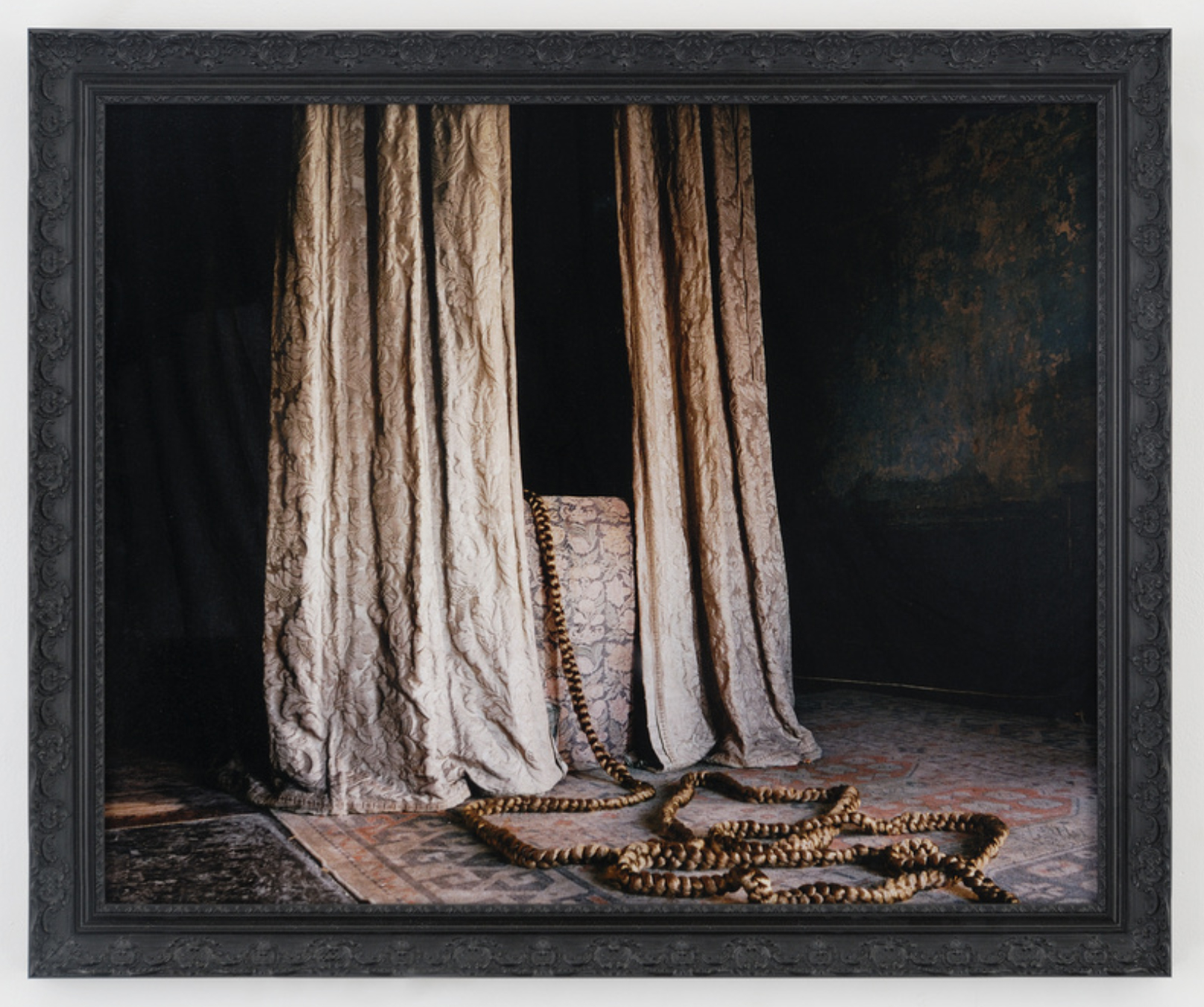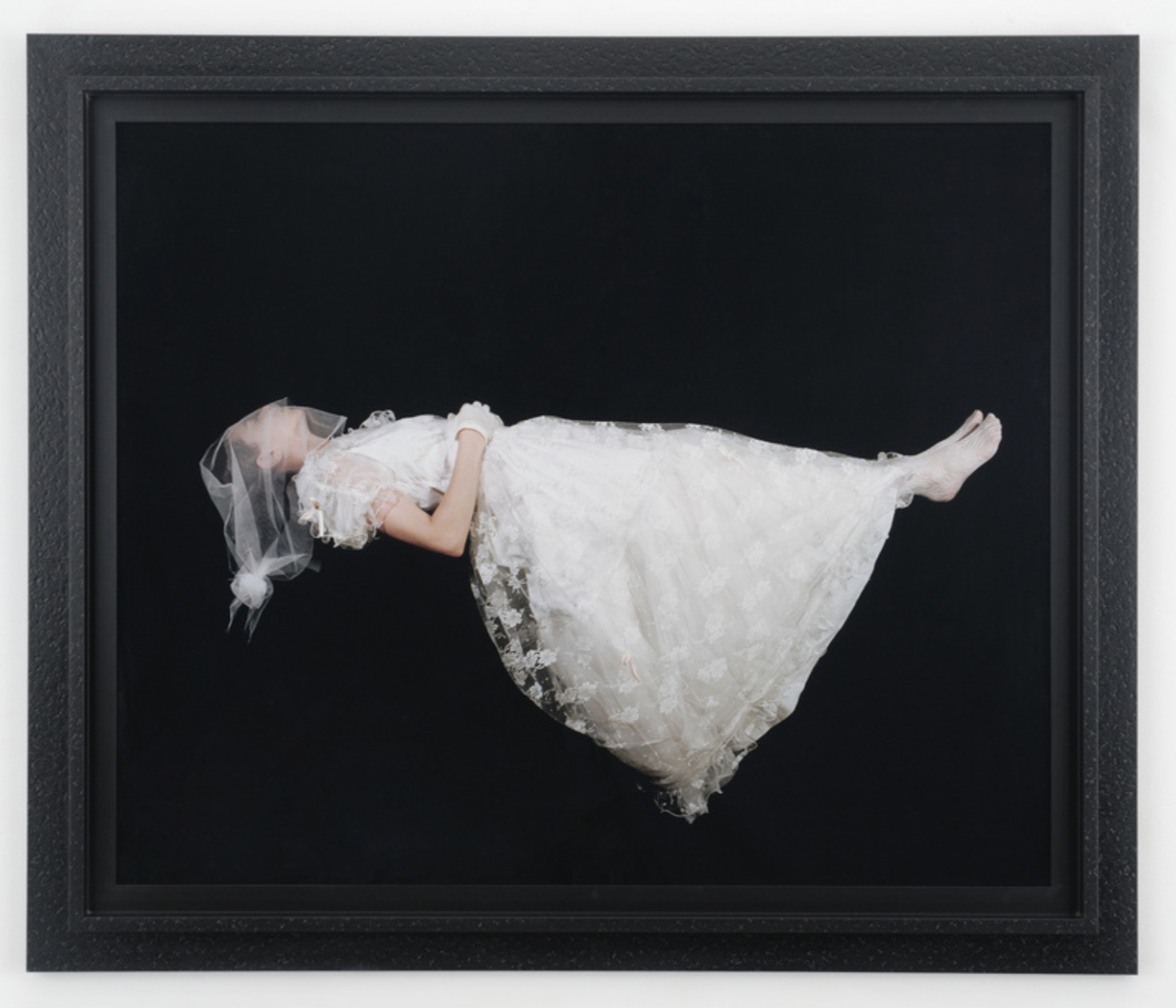
Le Lit d’Ursula, 2007
from the serie 11 Henrietta Street. Print 3/10
105 x 126 x 4 cm
Collection Frac Occitanie-Montpellier
Inv. : 09PH0923 (1) © Delphine Balley

Victoria jouant, 2007
from the serie 11 Henrietta Street. Print 8/10
105 x 126 x 4 cm
Collection Frac Occitanie-Montpellier
Inv. : 09PH0923 (3) © Delphine Balley

La veillée funèbre, 2007 from the serie L’Album de famille (Épisode de l’assissinat). Color photo on paper Print 2/10
133 x 156 x 8 cm
Collection Frac Occitanie-Montpellier
Inv. : 09PH0922 (1) © Delphine Balley
The Artist’s Website
Delphine Balley
Watch also
Le Pays d’en Haut
Qu’est-ce qui nous rassemble ?
Delphine Balley was born in 1974 in Romans-sur-Isère, she
lives and works in the Drôme. A graduate of the École nationale supérieure de
la photographie d'Arles, her work has been shown in numerous solo and group
exhibitions in art centers, galleries and biennials in France as well as in
Rome, Berlin and Seoul. Her work can be found in public and private collections
in France and abroad and has been the subject of commissions such as the one
carried out for four years with Les Nouveaux Commanditaires in Orthez. She
teaches image in various schools and professional training. In 2019 she was
awarded the Camera Clara prize, and in 2021, the MAC Lyon will devote a major
monographic exhibition to her.
Delphine Balley's images, often thought in series, dramatize life's playlets, family moments. The artist draws on the ancestral foundations of societies, beliefs and collective practices, is inspired by various events, re-enacts scenes from before or after the crime, and meticulously constructs intimate, disturbing, strange, and sometimes amusing universes, with a touch of derision.
Composed like paintings or in-depth storyboards, his works are inspired by true stories or report fictional stories often tragic, tales, penal chronicles, regional beliefs and local legends. Since 2013, the artist has been making films, a logical continuation of his photographic work. His influences are multiple, from Jean Giono to James Ellroy's thrillers, from the cinema of Luchino Visconti, Ingmar Bergman and Andreï Tarkovski to the paintings of Francisco Goya, Diego Velázquez, René Magritte, Giorgio De Chirico, passing through the social sciences, ethnology and rural anthropology with the writings of Yvonne Verdier and Marie-José Mondzain.
Everything is a question of balance in the work of Delphine Balley, between the underlying tension of the drama that is played out (visible in the globality of the image) and the escape of the viewer given by the details. The art of meticulousness and composition is found in her still and animated images, as much in the use of light and atmosphere as in the precise choice of actors, costumes, sets and framing. In his compositions, the artist elaborates a closed world where objects, patterned tapestries, furniture, carpets fill the image. The materials, attributes, accessories are used as clues in a profusion that leaves little room for perspective. The artist handles stories and symbols, refers to rituals and popular culture, and sometimes creates allegories of her own. Time is an essential element in her work process. Fascinated by 19th century photography, she photographs with a camera or medium format which induce slowness and latency. She prepares her shots for several hours, which has an impact and influence on the attitude and postures of her characters. Finally, she finalizes her images with a thick and molded frame, ebony or gold, which accentuates the pictoriality of the work.
La Réunion de famille and La Veillée funèbre are two photographs from the series "L’Album de famille" (chapter 1 Episode of the Assassination) that the artist created in 2007. Between 2005 and 2013, Delphine Balley stages herself with the members of her family and constitutes this great series "L’Album de famille" in two chapters, significant in her artistic research and from which will come her first film Le Pays d'en haut in 2013 (chapter 3 "L’Album de famille"). Based on a news story, the artist composes an enigmatic and dramatic fable, a fictional family saga. The images take up the founding elements that punctuate the life of a family (baptism, wedding, wake, etc.). The artist organizes the scenes. Heavy decorations accentuate the story and the unspoken, the past and future tragedies. Each character poses in a carefully studied attitude. In The Family Reunion and The Funeral Vigil it is a question of loss and ritual: marriage and mourning are linked by often similar protocols, in objects and exchanges.
Delphine Balley's images, often thought in series, dramatize life's playlets, family moments. The artist draws on the ancestral foundations of societies, beliefs and collective practices, is inspired by various events, re-enacts scenes from before or after the crime, and meticulously constructs intimate, disturbing, strange, and sometimes amusing universes, with a touch of derision.
Composed like paintings or in-depth storyboards, his works are inspired by true stories or report fictional stories often tragic, tales, penal chronicles, regional beliefs and local legends. Since 2013, the artist has been making films, a logical continuation of his photographic work. His influences are multiple, from Jean Giono to James Ellroy's thrillers, from the cinema of Luchino Visconti, Ingmar Bergman and Andreï Tarkovski to the paintings of Francisco Goya, Diego Velázquez, René Magritte, Giorgio De Chirico, passing through the social sciences, ethnology and rural anthropology with the writings of Yvonne Verdier and Marie-José Mondzain.
Everything is a question of balance in the work of Delphine Balley, between the underlying tension of the drama that is played out (visible in the globality of the image) and the escape of the viewer given by the details. The art of meticulousness and composition is found in her still and animated images, as much in the use of light and atmosphere as in the precise choice of actors, costumes, sets and framing. In his compositions, the artist elaborates a closed world where objects, patterned tapestries, furniture, carpets fill the image. The materials, attributes, accessories are used as clues in a profusion that leaves little room for perspective. The artist handles stories and symbols, refers to rituals and popular culture, and sometimes creates allegories of her own. Time is an essential element in her work process. Fascinated by 19th century photography, she photographs with a camera or medium format which induce slowness and latency. She prepares her shots for several hours, which has an impact and influence on the attitude and postures of her characters. Finally, she finalizes her images with a thick and molded frame, ebony or gold, which accentuates the pictoriality of the work.
La Réunion de famille and La Veillée funèbre are two photographs from the series "L’Album de famille" (chapter 1 Episode of the Assassination) that the artist created in 2007. Between 2005 and 2013, Delphine Balley stages herself with the members of her family and constitutes this great series "L’Album de famille" in two chapters, significant in her artistic research and from which will come her first film Le Pays d'en haut in 2013 (chapter 3 "L’Album de famille"). Based on a news story, the artist composes an enigmatic and dramatic fable, a fictional family saga. The images take up the founding elements that punctuate the life of a family (baptism, wedding, wake, etc.). The artist organizes the scenes. Heavy decorations accentuate the story and the unspoken, the past and future tragedies. Each character poses in a carefully studied attitude. In The Family Reunion and The Funeral Vigil it is a question of loss and ritual: marriage and mourning are linked by often similar protocols, in objects and exchanges.
In La Veillée funèbre, the body of a modern Ophelia floats on a black background. Delphine Balley plays the "legitimate daughter" murdered on her wedding day. The confusion comes from the serenity of the face of the deceased, her veil tied. The chiaroscuro refers to the paintings of Caravaggio.
Many details are present in La Réunion de famille, such as the oversized plant hat worn by the mother, first for the wedding ceremony and then to hide her sadness. It will continue to grow in the other images of the series, to the point of invading the dining room with ivy, around the husband's cover, announcing the decline of the family. The seven members gathered in the living room around the wedding cake wear a mourning veil or a funeral mask, like Myriam, dressed as a horsewoman throughout the series, whose golden mask covers half of her face, a clear symbol of another misfortune. The mystery and poetics of the photographs as a whole weave the fantastic adventure of this family. Individually, each one is constructed so that a narrative exists and brings sufficient detail to the whole.
11 Henrietta Street is a series of 15 photographs for which Delphine Balley was inspired by the treatment of news stories in the tabloid press, mainly in England. In the Victorian society of the nineteenth century, against the background of Charles Dickens, the artist invented the chapo of one of the most famous tabloids of the time, the News of the World of Sunday, March 14, 1872: "Margaret Platt, 79 years old, cut off the 78-foot-long braid of her daughter Ursula, 43 years old, on a beautiful summer afternoon".
Ursula, Le lit d’Ursula, Victoria jouant and Le Sofa depict the story, imagined by the artist, of this possessive and castrating mother who decided one day to cut the pigtail of one of her three daughters, more than 23 meters long. Ursula, the eldest of the siblings, lived cloistered, watched over and dominated by an all powerful mother. Here the artist takes up the aesthetic of the bourgeois family portraits of this austere and puritanical era, which was the result of the first industrial revolution. The images content the different stages, as the public could have discovered them in the newspaper. The details in each image are so many clues that allow us to recreate the plot and to imagine what is not there, reinforced by the use of natural light (unlike L’Album de famillewhere artificial lighting dominates). We find the taste of the time for busy interiors and exotic naturalized animals, trophies of the colonies. The costumes, embroidery and veiled dresses that hint at nudity are allusions to Ursula's coming loss, the black mantilla, the face hidden from her sister Victoria by a wall of hair, and her offbeat children's games, all elements that evoke latent violence and heaviness, between realism and fantasy. As in the photographic portraits of the nineteenth century, Delphine Balley works to not create a scale of value between the characters, objects, furniture and animals. Everything is clean and precise, everything is part of the family portrait.
— Émilie Flory
August 2021